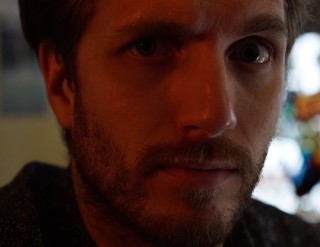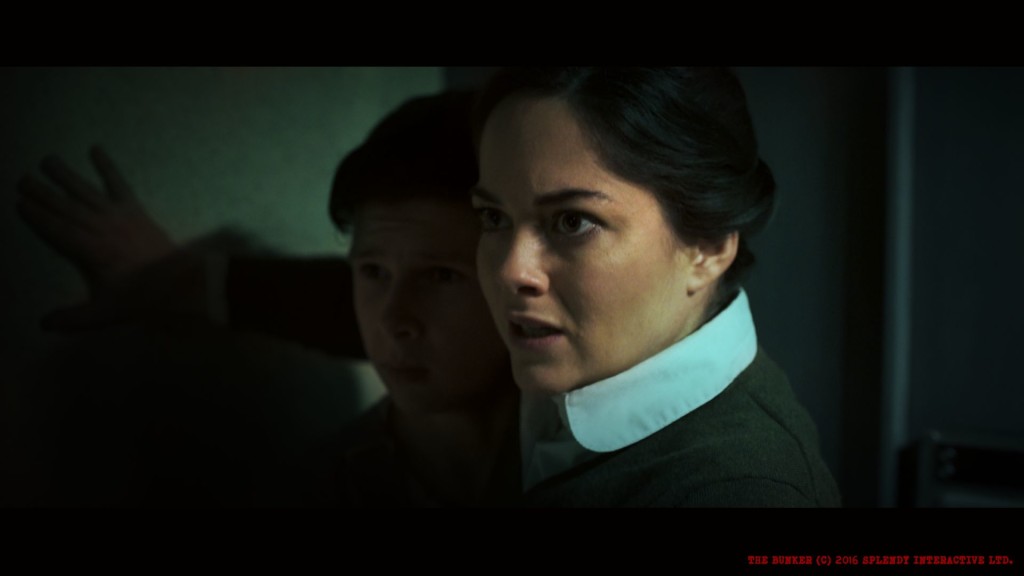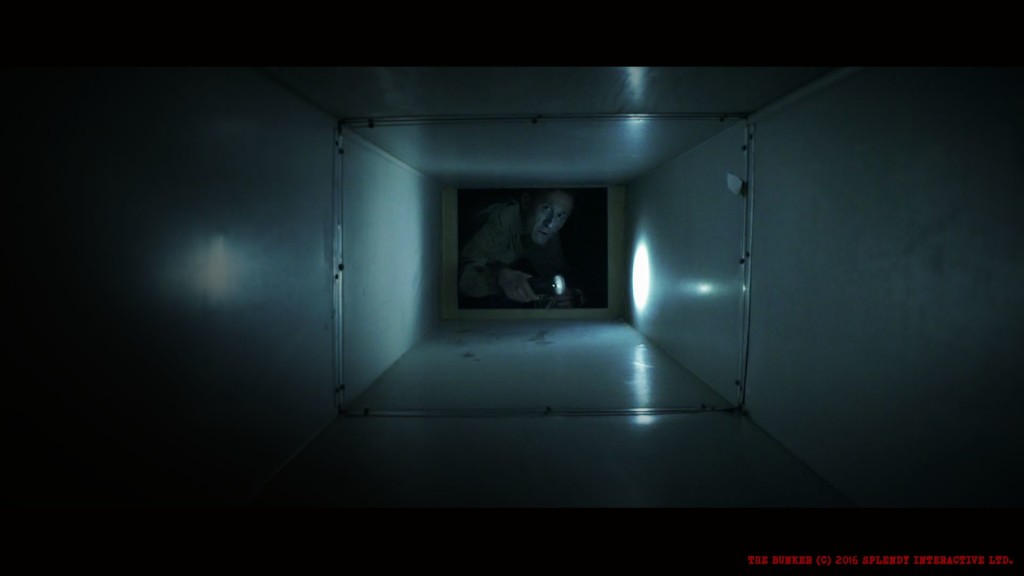The Bunker, which comes out this year for PC, console and mobile devices, blends filmmaking with interactive gaming for a completely unique experience. Filmed entirely inside a real-life decommissioned nuclear bunker, and starring Adam Brown (The Hobbit trilogy) and Sarah Greene (Penny Dreadful; Assassin’s Creed IV: Black Flag), the horror-suspense game features all live-action footage with no CGI. It’s something that blurs the line between watching a movie and playing a game, which makes it quite the project for developer Splendy Interactive to take on.
Simon Sparks, co-founder of Splendy and producer on The Bunker, sits down with [a]listdaily to talk about the challenges in making and promoting an interactive movie that takes you to the depths of the unknown.

What is The Bunker about?
The story is about a boy named John, who was born in the bunker on the day England was wiped out through nuclear war. It’s 1986, and nuclear war has happened, and the day that the bombs hit, his mother, who worked for the government, was rushed down into the bunker and the trauma kickstarted the childbirth. So, as the world ends, he is born.
He lives his whole life in the bunker and we join him 30 years later, and he’s alone. All he knows is his routine (checking radiation levels, inventory stocks, etc.) which is keeping him alive, and he’s very stringent about it. But when something goes wrong, he’s forced to venture deeper into the bowels of the bunker, which his mother told him not to go into. Before her death, she warned him to stay on the level of the bunker, and to never leave. As John goes into the bowels, it awakens suppressed memories and uncovers the dark and hidden past of the bunker.
Through these repressed memories, he is faced with the true reason he is down in the bunker.
Why was The Bunker developed using only live-action footage instead of computer graphics?
Our first game was a live-action survival horror called The Hunting, which is only available on iOS. We filmed the whole thing using an iPhone 4s, which my business partner Allan still has. We basically did a vigilante film with no budget. We had enthusiasm and duct tape, and Allan wanted to explore whether we could make a movie that you could play as an app.
After we released it, we found out that there was a real appetite for something different, and we wanted to do something different as well—bigger and more ambitious. With live-action, you can really capture genuine performances from actors, which will move you in a way that even the best mocap and CG rendering can’t quite capture—the performance of an actor on film. It’s that kind of connection with the characters that we really wanted to explore. The reason we use live-action is for the emotional connection, rather than a kind of gimmick.
We wanted to explore how to connect with players on a different level while using the storytelling and immersiveness that comes with that.
Is The Bunker inspired by FMV games from the ’90s?
It wasn’t intentional. It’s not like we woke up one morning and said, “we’re going to reinvent FMV.” We started off making apps, and for us, it was more that it was more entertainment than a game. But we quickly started to make a kind of noise in the games industry, and it was just through contacting publishers and by sheer chance that we learned whether this kind of thing existed and whether people would buy it. It was from that that we decided to bring the game to PC and consoles, rather than just sticking with apps. That is where more of our real market is.
So, making a sort of homage to FMV was never a consideration, but it just happens that articles are throwing that acronym around. But look at games like Quantum Break replicating their actors as best as possible, while saying, “hey look, we have a Hollywood actor in here.” That’s the CGI version of him, and here he is in the live-action episodes. Then there’s Her Story, which featured Viva Seifert. For me, it’s hard to say that this is FMV. It’s its own sub-genre that’s hard to place.

How did Adam Brown and Sarah Greene become involved with The Bunker?
Allan, the director and writer, is a big fan of fantasy and games. He’s the guy who watches the director’s commentary and behind-the-scenes stuff, because he’s fascinated by the whole process. He became aware of Adam through watching a behind-the-scenes bit for The Hobbit. He came across as a really smart guy who was passionate about what he did. Then you start to pay more attention to him in the films, and he’s got a lot of screen time in The Hobbit—way more than we thought he did, and he is a great actor.
We spoke to his agent and did all the normal stuff. When we finally met him, he had this kind of vulnerability that lent itself to the role. We wanted the player to feel protective of the character, John, and he brought it. He was excited about the project and was open to something new.
As for Sarah, she’s just one of those up-and-coming, great new actresses. If you see any of her stuff, she’s just fantastic. It was one of those things where we knew what we wanted, but didn’t know what it was, and it wasn’t until we saw her and look at her varied performances that we realized it. She was also the voice of Anne Bonny in Assassin’s Creed, so she was open to all sorts of different roles.
It also turned out that Adam and Sarah are great friends. They’ve known each other for years, and it was very exciting, because it added to this great atmosphere on set.
All the filming was done in a decommissioned nuclear bunker. What’s the story behind that?
The UK has a number of secret nuclear bunkers, and in 1992, it was deemed that there was no longer a nuclear threat. So, they kind of just left them. Everything that was in The Bunker was left by the UK government in 1992, and it’s a real mixture of the kind of fear during that time.
It took them several months to dig out the side of this hill in the 1950s. They [the government] just turned up at this farm and told them, “We’re having this farm. And if you tell anyone, you’ll be done for treason and go to prison.” So, they took the farm off them and pretended to have a farm while they dug out a bunker that could house 600 people.
Through the ages, it was upgraded with new technologies, like Teletext. There are all sorts of analog stuff there, along with some digital stuff up to the Commodores. It’s amazing, and then you find things like toe-tags. Someone actually had to sit down and think about the stationary needed in the apocalypse.
It’s currently a privately run museum. We were looking for a location to shoot a demo, and didn’t have a story in mind until we found this bunker in Essex. The guy who owned it took us on a tour off the beaten track, so we got to see behind locked doors. Then we just started writing and coming up with stories after we left. That’s when we started talking to publishers, like our friends at Green Man Gaming. We wanted to do a TellTale game, but with movie footage.
The story began to evolve and change as we got writers on board who had worked on Soma, Broken Sword, and The Witcher. They added a different level to it and looked at it from a game point of view. The story became way more grown-up, and we really rammed home the emotional connection. We would not have made this game if we hadn’t found that nuclear bunker. The bunker is very much a character in it.
How will you be getting the word out about The Bunker when it releases?
We’re in an interesting position because this hasn’t been done before. It should be relatively easy to get some attention. When we released the trailer on April 4, it was the number-one marketing asset in the whole of the games industry for that week, above Doom. That’s just awesome.
But we’re now in a position where one would traditionally give people a demo and give streamers half or the entire game so that they can tell everyone about it. However, if you’re watching someone watching a movie, you can’t do that ten minutes into it. You have to be very careful and considered about how you do it. Green Man has a strong streaming community, and it looks like we’re going to give them a demo that’s about 30 to 45 minutes long. We’re trying to make it more of an event so that people will join in from the start.
We’re getting the word out about The Bunker by removing all the “gimmicks,” like how it’s live-action, and getting to the core of what it is. It’s getting people to understand what the game is in one sentence. As long as we can translate that, then I think the guys will have done a really good job. We don’t want to be the game that’s live-action. We want to be the game with a really good story that makes people think. We’re relying closely on Green Man on the initial launch.

What are the challenges in promoting a game across PC, console and mobile platforms?
They all have their nuances, and it’s making sure that they don’t conflict that counts more than anything. It goes back to getting to the core message of what the game is. After we get our message across, then it will be up to the consumer to decide where they want it. We don’t want the messages to conflict, so that everybody feels like they’re getting a fair deal, and no platform is particularly better.
The challenges come down to when we release them over the next year. We’re only a small team of people, and there’s only so much we can do at once. So, we’re focusing on PC first, then console, and mobile afterward. We’re hoping to get the mobile version out before Thanksgiving. We’ve got three publishers as well, one for each platform, and so far they’ve all been great and respect one another.
Have you given any thoughts to using VR technology with games like The Bunker?
Yes, we have. It’s very hard to be in the games industry and not have this crop up. It’s so hot right now. Everybody is asking, and everybody wants VR, and it’s great… but really expensive.
VR has its own set of challenges. I’m confident that VR will one day be awesome, but you’ve got to be realistic. The games industry has taken a lot of time and talented people to get it where it is, and I think the same will be true for VR. It’s very delicate at the moment, and I’m worried for it because there’s a lot of hype and expectations are high. Luckily, there’s some really good content and a number of different platforms available. But we need to give it time to find its own way and not judge it too much. There is the worry that VR might go the way of 3D TV.
If VR were a friend, I’d be taking it down to the pub right now and saying, “You’ve got to be really careful. There are a lot of people out there expecting big things of you.”
As for doing what we do, there are so many challenges. How do you direct a story in 360? How do you get across an emotional connection, and how do you know if they’re watching a bit of dialogue? Where does the crew go when filming in 360? You basically have to hide in another room, and hide all the cables everywhere.
VR is on our radar, but it requires patience, time and more people. It can’t be a gimmick. It has to be a driving force in the story.

